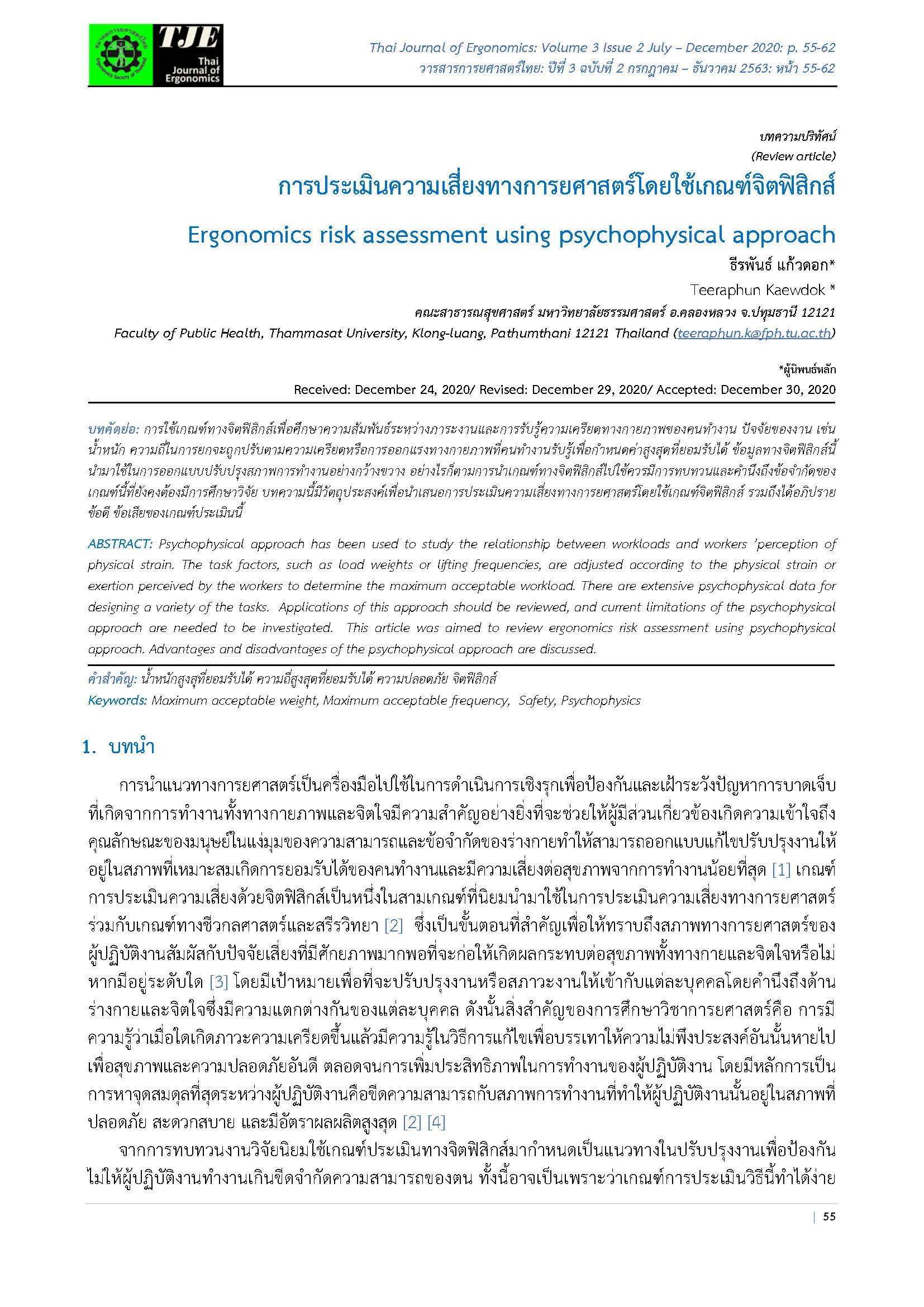Ergonomics risk assessment using psychophysical approach ธีรพันธ์ แก้วดอก*
Main Article Content
Abstract
Psychophysical approach has been used to study the relationship between workloads and workers ’perception of physical strain. The task factors, such as load weights or lifting frequencies, are adjusted according to the physical strain or exertion perceived by the workers to determine the maximum acceptable workload. There are extensive psychophysical data for designing a variety of the tasks. Applications of this approach should be reviewed, and current limitations of the psychophysical approach are needed to be investigated. This article was aimed to review ergonomics risk assessment using psychophysical approach. Advantages and disadvantages of the psychophysical approach are discussed.
Article Details

This work is licensed under a Creative Commons Attribution-NonCommercial-NoDerivatives 4.0 International License.
References
นริศ เจริญพร. เอกสารการสอน ชุดวิชาการยศาสตร์. พิมพ์ครั้งที่ 2 ed. นนทบุรี: โรงพิมพ์มหาวิทยาลัยสุโขทัยธรรมาธิราช; 2554.
Ayoub MM, Dempsey PG. The psychophysical approach to manual materials handling task design. Ergonomics. 1999;42(1):17-31.
สุดธิดา กรุงไกรวงศ์. เอกสารการสอนชุดวิชาการยศาสตร์และจิตวิทยาอุตสาหกรรม มหาวิทยาลัยสุโขทัยธรรมาธิราช. พิมพ์ครั้งที่ 2 ed. นนทบุรี: โรงพิมพ์ มหาวิทยาลัยสุโขทัยธรรมาธิราช; 2563.
กิตติ อินทรานนท์. การยศาสตร์. พิมพ์ครั้งที่ 2, ed. กรุงเทพฯ: สำนักพิมพ์แห่งจุฬาลงกรณ์มหาวิทยาลัย;
Bhattacharya A, and McGlothlin, J. D. Occupational ergonomics: Theory and Applications. 2 ed. New York: Marcel Dekker, Inc. ; 2012.
Mital A, Nicolson, A. S., and Ayoub, M. M. A guide to manual material handling. 2 ed. London: Taylor and Francis Ltd. ; 1997.
Pinder ADJ, Boocock MG. Prediction of the maximum acceptable weight of lift from the
frequency of lift. Int J Ind Ergon. 2014;44(2):225-37.
Charoenporn N, Outama A, Kaewdok T, Eard P, Kooncumchoo P. Maximum Acceptable Weight of Lift in Adolescence Aged 15 to Less Than 18 Years Old. Adv. Intel. Syst. Comput. 2019;826:778-88.
Lee KS, Hwang J. Determination of maximum acceptable and comfortable height during one handed lifting. Work (Reading, Mass). 2020;65(3):497-507.
Widia M, Dawal SZ, Yusoff N. Maximum acceptable frequency of lift for combined manual material handling task in Malaysia. PLoS ONE. 2019;14(5):1-13.
Marras WS, Karwowski W. Intervention, Control and application in occupational ergonomics. New York: Taylor and Francis; 2006.
Borg G. A general scale to rate symptoms and feelings related to problems of ergonomic and organizational importance. G Ital Med Lav Ergon. 2008;30(1 Suppl A):A8-10.
Gamberale F. Perception of effort in manual materials handling. Scand J Work Environ Health. 1990;16 Suppl 1:59-66.
สิริอร วิชชาวุธ. จิตวิทยาอุตสาหกรรมและองค์การเบื้องต้น. พิมพ์ครั้งที่ 3 ed. ปทุมธานี: สำนักพิมพ์
มหาวิทยาลัยธรรมศาสตร์; 2553.
Schiffman HR. Sensation and perception integrated approach. McGraw Hill John Wiley & Sons.; 2001.
Borg G. Psychophysical scaling with applications in physical work and the perception of exertion. Scand J Work Environ Health. 1990;16 Suppl 1:55-8.
Ljungberg AS, Gamberale F, Kilbom Å. Horizontal lifting— Physiological and psychological responses. Ergonomics. 1982;25(8):741-57.
Snook SH, Ciriello VM. The design of manual handling tasks: revised tables of maximum acceptable weights and forces. Ergonomics. 1991;34(9):1197-213.
Wu S-P. Maximum acceptable weights for asymmetric lifting of Chinese females. Appl Ergon. 2003;34(3):215-24.
Wu SP, Chen CC. Psychophysical determination of load carrying capacity for a 1-h work period by Chinese males. Ergonomics. 2001;44(11):1008-23.
Wu S-P. Psychophysically determined 1-h load carrying capacity of Chinese females. Int J Ind Ergon. 2006;36(10):891-9.
ธีรพันธ์ แก้วดอก. เกณฑ์ทางด้านการยศาสตร์เพื่อพิจารณาความปลอดภัยและความเสี่ยงในงานที่ใช้แรงกาย. วารสารการยศาสตร์ไทย. 2563;3(1):54-64.
Hutchinson JC, Tenenbaum G. Perceived effort — Can it be considered gestalt? Psychol Sport Exerc. 2006;7(5):463-76.


